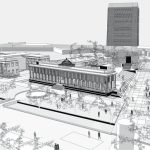
 The 21st century brings with it a number of diverse functions required to suit the growing needs of the people. With the growth of population, change of trends, available consumer items, and activities, communities globally are faced with the ever persistent problem of housing these varied needs of society. The ephemeral quality of the needs of the people together with the permanence of the building poses the problem of predictable redundancy. It is inevitable that a building built for a specific purpose to house a precise function will, with the passing of time, cease to be employed.
The 21st century brings with it a number of diverse functions required to suit the growing needs of the people. With the growth of population, change of trends, available consumer items, and activities, communities globally are faced with the ever persistent problem of housing these varied needs of society. The ephemeral quality of the needs of the people together with the permanence of the building poses the problem of predictable redundancy. It is inevitable that a building built for a specific purpose to house a precise function will, with the passing of time, cease to be employed.
The problem therein lies where a building cannot simply be removed from a context that has changed over time and replaced with one which will suit the given time and place.
The only economical solution for this persisting dilemma is the process of adaptive reuse. Adaptive re-use is the answer behind the salvation of many redundant buildings, which have over time lost its value due to the change in the function it was built for. Historical buildings can also be salvaged from both economic and functional redundancies as adaptive re-use can breathe new life into these now dead structures. Buildings with historical values and ceased functions serve as a structurally suitable shell for new functions. A mix of the old and the new in terms of new functions residing within old building creates functionally legitimate cities riddled with historical value, giving rise to novel technique of keeping history and culture alive in an ever-changing society.
Adaptive re-use has become increasingly popular among many architects and the public as a sustainable means of construction. Adaptive re-use minimises the construction and reduces the use of new materials, pollution and waste brought on by construction, which are all additional, sustainable benefits gained through this process. A great degree of skill and care are often required as sometimes drastic changes need to be implemented to the spatial layouts to suit the new function, which will reside in the old structure. It may be that interior and exterior refurbishments are necessary to make the buildings habitable and suitable to a new society. It is also of vital importance to be able to distinguish between buildings which can be re-used from those that cannot. Buildings which lack historical value, structural stability and durability,
or buildings which will cost more to revitalise than to replace are limiting factors which need to be identified early into the project. These will in most certain terms identify the degree of the intervention required in the adaptive re-use process, adding to the accuracy of its economic assessment.
Adapting new functions to old buildings is not a novel idea; it is a concept which goes hand in hand with conservation and restoration. Conservation of the building, energy, labour and materials and restoration of function, history and culture add to the importance of implementing this process. It is a healthy process practiced as a strategy, aimed at adding to the global agenda of sustainability.
Peshali Perera











